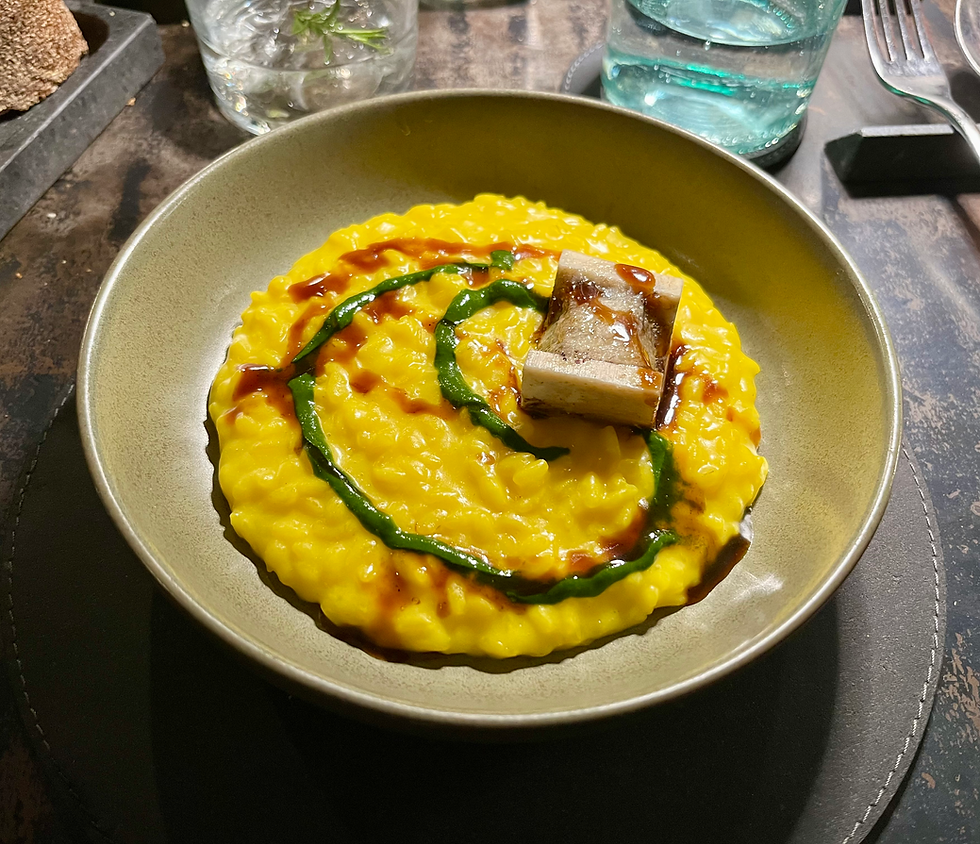Johnny Ortiz in Residence at Stone Barns – Pocantico Hills, NY
- the_maestro

- May 6, 2021
- 14 min read
“At the other places I worked, it was always about the outcome . . . The ingredients were less the focus than the idea. Here, the ingredients are the best, and they tell a story about the place. We’re just showing some possibilities—inspiring people to look at their life differently.”
It's really strange for me to have settled on the east coast. I feel little connection to the east––the landscapes, the pacing, the wildly different spatial universe, the culture, the sense of time. I am a child of the American west, and always will be. I crave the open spaces, the mountains, the ethos of the west. The world seems so much more connected to the land and the place around us than out east. Our lives as west-coasters are tied to the land; they are part-and-parcel with the world around us.
Of course, I have appreciated finding places of natural beauty that can mimic the connection I feel to the Earth I have when I am back west. The glorious Great Smoky Mountains just a few hours from Charlotte. The rolling sparseness of Appalachia. And, of course, the beauty, culture, and attitudes of a place like Stone Barns.
Stone Barns is quickly becoming a place of pilgrimage. I go here to soothe what aches witnessing the inequities and destructiveness of our food systems. It is a place where everyone around me feels the same way about food, agriculture, and ecology. And even though it's on the east coast, my connection to New York City, the Hudson Valley, the people here, and the work they do gets stronger each time I visit.

After two spectacular, thought-provoking, and deeply moving meals from east coast-based chefs at Stone Barns, I was very excited to make yet another journey to the Hudson Valley to experience the food of Johnny Ortiz, a wunderkind of indigenous Taos Pueblo and Latino descent from northern New Mexico, much closer to my neck of the woods. Ortiz is not even 30 and has been making waves in the culinary world since his early 20s. His project before the pandemic, / Shed, housed in a tiny town in New Mexico, quietly became one of the most exciting food experiences out west. He's hoping to re-open it by the end of the summer, and I will certainly make a voyage to try it.
Johnny's pedigree is unrivaled for his age. At 19, he essentially walked right into the kitchen at Alinea in Chicago, which had just earned its third Michelin star. Just a few years later he found himself at the legendary Willows Inn on an island in Puget Sound. Here, Chef Blaine Wetzel, who worked at Noma in Copenhagen, a restaurant many consider to be the absolute best in the world, was pioneering a locavore concept, one of the few in the country at the time. Wetzel got everything he could from just the island and environs, teaching Johnny to forage in the wilderness and about seasonality, concepts with which he was already familiar as an inheritor of indigenous traditions. This was a formative stage for Johnny's culinary ethos––what some might call "wilderness-to-table."
Johnny got his biggest break at the then-brand-new Saison in San Francisco, quickly earning the title of sous chef under Joshua Skenes, and in his second three-Michelin-star kitchen before age 25. This likely means that Johnny was cooking for me the evening I enjoyed my sole meal at Saison in 2015 before Skenes stepped aside. Since then, Skenes has developed Angler, also in San Francisco, which has been garnering critical acclaim like crazy, and which I visited, albeit briefly, back in 2019.
Skenes' philosophy can be best summed up as "what is the best version of this ingredient, what does it taste like, and how I can I make it taste its absolute best and the most like itself without futzing with it too much." Such a philosophy was right in line with what Johnny had learned at Willows Inn, though wildly contrary to the showmanship of Alinea. Josh Skenes, in fact, is known as a forager, hunter, and fisherman as well as a chef, connected to every stage of the finding, prepping, and cooking of ingredients. Johnny Ortiz's world is similar––he forages himself, tends the farm he has developed, and is deeply connected to the land he calls home in northern New Mexico. All of this is against the backdrop of time––Johnny views his project as a meditation on the fleetingness of time and seasons, and the peak seasonality of the ingredients he forages and harvests.
“I want to be connected to each step—to forage and tend animals and farm and make ceramics . . . I spend the least amount of time in the kitchen . . . [Dinners] are just the fruiting body of the work—mostly I’m interacting with the landscape and nature.”
The goal was always to return home, Johnny says, and reconnect with the land he knew and loved growing up––"This is where I was born and this is where I will die." Dinners at / Shed exude simplicity, focus, and minimalism. The ingredients, in their best form, take center stage, and there are rarely more than four or five of them in a single dish. This philosophy seems to gel rather well with Stone Barns' work, albeit in a much more "wild west" sort of way. I was really excited, and interested, to see how Johnny could bring his culinary philosophy, one so connected to the west, to the land he knows, to the indigenous practices and places of his ancestors, and bring it to the farmland and forests of the Hudson Valley, without losing his unique perspective. I was also really excited as a child of the west to see how a west coast kid would use the lens of Stone Barns' east coast bounty to execute his vision.
* * *
"/ Shed: Verb: to set apart, to resist being affected by, to cast off or let fall off by natural process, to promote new growth."
A beautiful, bright spring Saturday was the backdrop for the meal, and the property was bustling with people enjoying the warmer weather and sunshine. I was lead to my usual spot overlooking the dining room in the barn, the table in the center adorned with paper bag lanterns, unlit during lunchtime, but, as I saw on Instagram, glowing warmly during dinners. The parade of people greeting me and welcoming me back made me feel, as always, right at home.

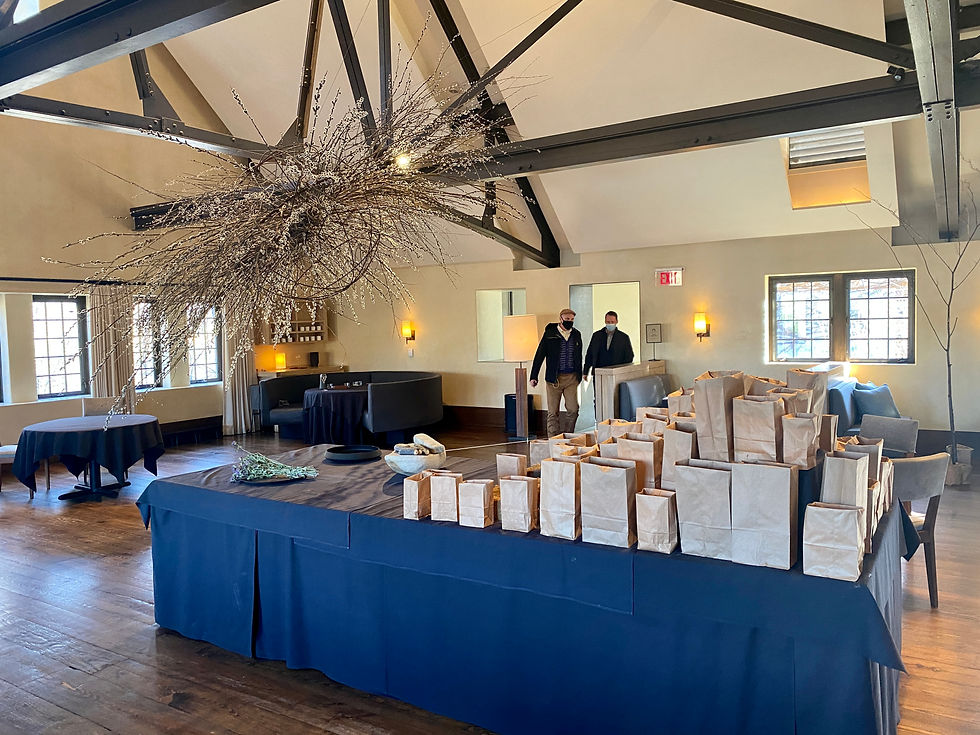

Hannah's counterpart in wine––I am embarrassed to say I haven't learned his name yet––welcomed me by pouring a fantastic Hudson Valley cider from Sundström, made in the traditional champenoise method, but with apples. I was thirsty and it was a little ridiculous how good and drinkable it was, so it disappeared quickly, and when Evan made his way to my table, I was ready for a cocktail. They change their cocktail list with each residency, and the list this time emphasized wild-foraged ingredients and botanicals from the area as well as the spirits of the southwest and Latin America. This meant I absolutely had to get their take on a pisco sour (Evan agreed heartily) made with wild rose (the first plant Johnny learned to forage from his grandfather) and bird cherry. A gorgeous drink.

Jenny, my lead server, and the same sherpa I had last time, stopped by to welcome me back and introduce me to Johnny's work, only to find I was already quite familiar with what he'd been doing. Pointing my attention to the courtyard, she described the horno, a traditional clay cooking vessel that would be a centerpiece of cooking methods used throughout the meal. The horno was made from a thousand pounds of adobe bricks brought to New York by Johnny from his home in New Mexico, with clay from the same land.

Johnny was quite taken with the very happy and healthy cows on the Stone Barns property, and much of the meal featured these glorious animals. The first dish was a warm beef bone broth flavored with sweet fern leaf and served in Stone Barns' famous bone china, made from the bones of slaughtered animals used on the farm. Nourishing and comforting, it was a perfect way to start the meal.

Duck potato is something I have seen at several of my meals at Stone Barns. A tuber that more resembles a rutabaga, they grow wild in the area, and have been a source of food for indigenous North Americans for centuries. The Aussie on staff, another buddy of mine, brought me two pieces of smoked fish on duck potato chips––trout, which had been cold smoked, and whiting that had been hot smoked. Both were delicious, but the flaky trout was my favorite, with a subtle smoke and delicate texture.
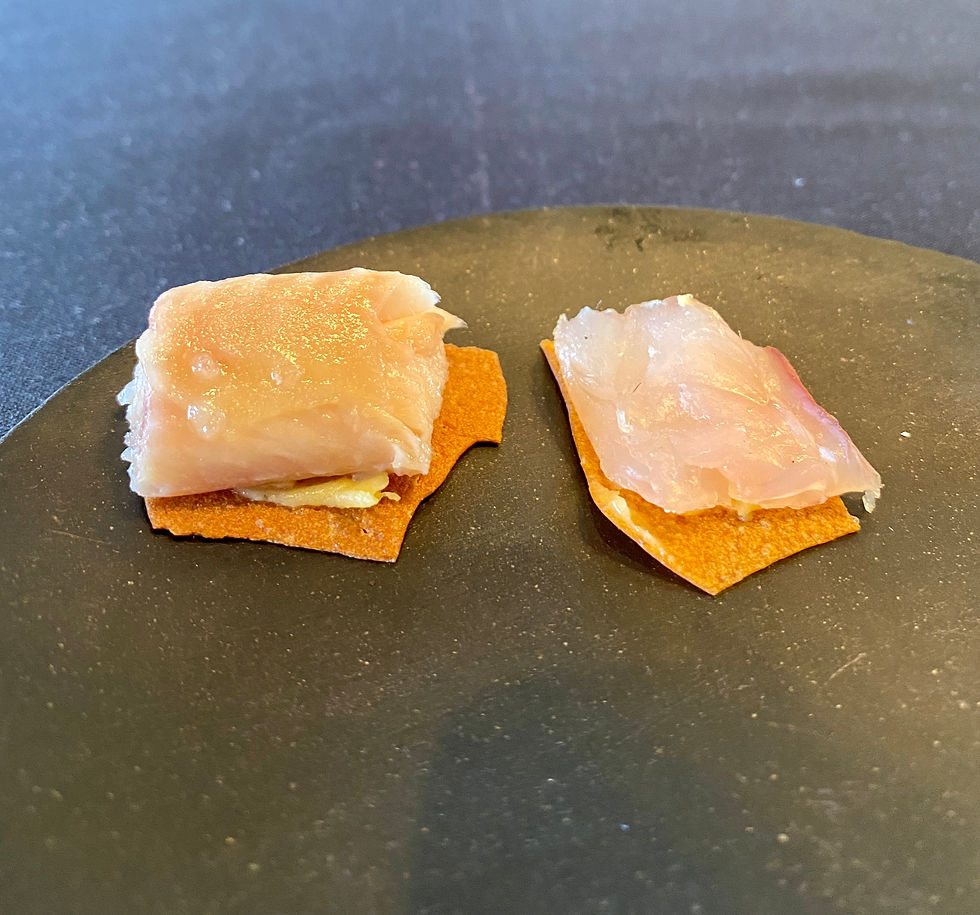
Low on beverage, I went with Evan's second-place suggestion for a cocktail next, which was a mezcal-based beverage flavored with sumac and yellow chartreuse. Just smoky enough, with a combo of chartreuse and sumac that almost lent it a citrus-like character despite there being absolutely no citrus in the cocktail.

Another little piece of fish was next––a slice of raw millet, served with knotweed, begonia, and a smear of cured millet roe. Absolutely delicious, and a window into how the meal would be constructed, with foraged wild ingredients playing a central role.

Shellfish was next. Johnny would later explain to me that even though this wasn't home for him, and so he is generally unaccustomed to working with shellfish in New Mexico, he wanted to highlight some of the sea-based glories of the Northeast coast. From left to right in the photos below, the selections were raw Maine scallop with habanada vinaigrette and husk cherry, steamed Maine mussel with apple cider vinegar and chive blossom, and razor clam lightly cooked with wild garlic and daylily. Also joining this course was a Long Island oyster called "Widow's Hole" with pickled melon and milkweed capers, though I stupidly slurped that up without photographing (it was my favorite one, too, but in fairness it just looked like an oyster). All were simple, exceptional, and beautifully presented. Midway through, they brought me half a head of baby red romaine lettuce from the greenhouse dusted with seaweed from the Atlantic coast and dressed with bitter lemon. Just incredible.
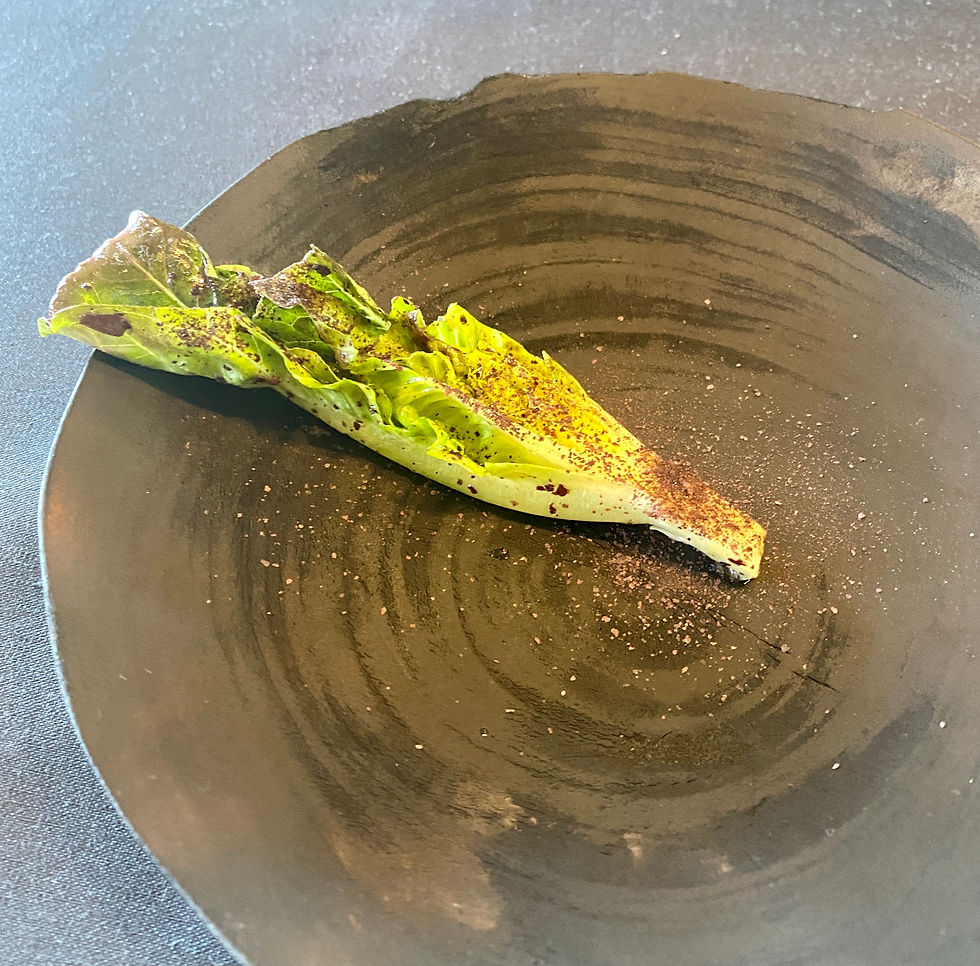
Next up was a custard of Stone Barns egg topped with a Hakurei turnip and sugar kelp broth, which was made with both the root and the leaves of the turnip, and yet was a transparent yellow in color. You may remember my little celebration of hakurei turnips from a few weeks back. Tasty indeed, but my least favorite course of the day (and really the only thing that was even anywhere close to a "miss" for this meal).

I read Braiding Sweetgrass, a spectacular book by Robin Wall Kimmerer, an indigenous botanist, about a month ago, and she had a remarkable chapter about indigenous, pre-colonization agricultural practice in North America known as the "three sisters." Corn, beans, and squash grow together in this form of planting, each providing some and taking some from the others and working in perfect symbiosis.

Johnny, a descendant of the Taos Pueblo people, deployed the three sisters in this next course, which was delicious in a way I cannot possibly describe. Stone Barns beans were served in a sunchoke broth that blew my goddamn mind––it was seriously the most delicious thing I had eaten in a long time, and so simple! A carryover from Saison was the vehicle for the squash––fermented squash purée with squash seed oil, a dish I'd had when I ate at Saison and (I believe) Johnny was working there as sous chef (except this was made with pumpkin at Saison). Incredible. Last but not least, no visit to Stone Barns is complete without some house-made bread. Here, the breadmakers use wheat (a "fourth sister," which helps provide nutrients for the other three) and a sour corn mash to produce a dense, earthy bread. What a knockout course.
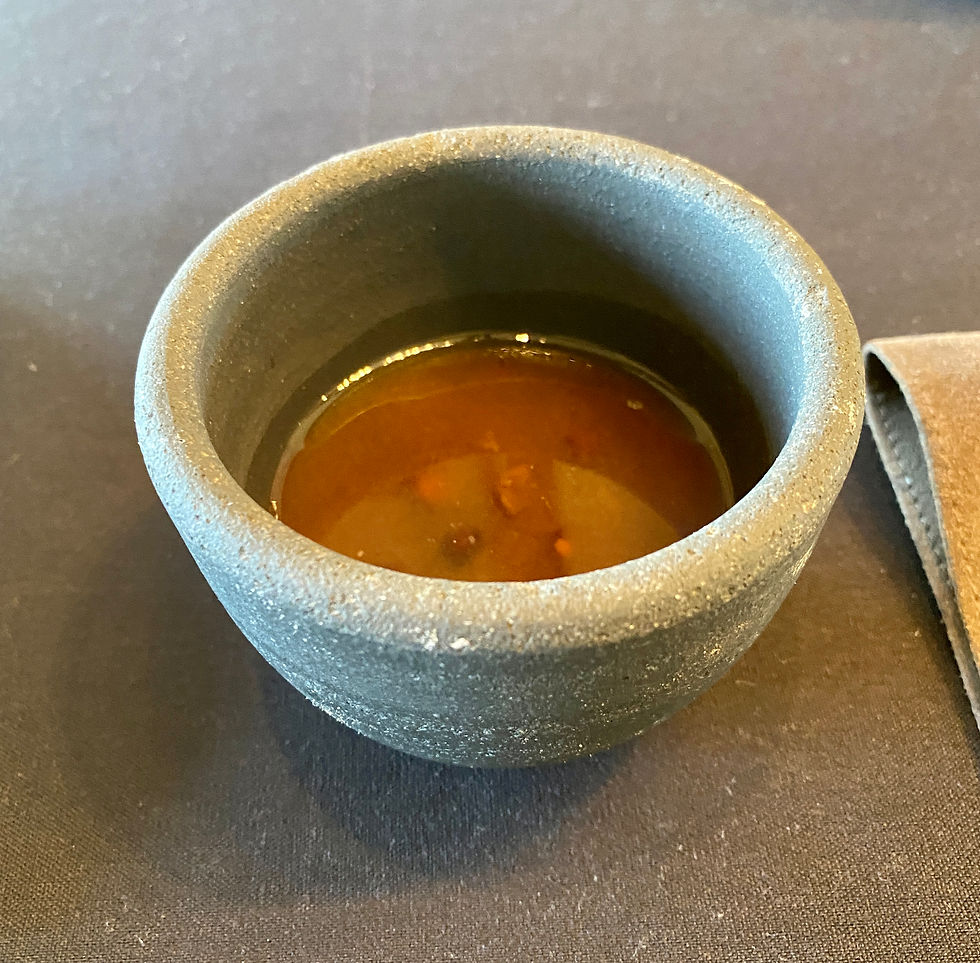

In advance of the next course, I asked for some wine––"whatever goes best with what is to come." From Alto Adige in the Italian pre- Alps, this red is made by a rule-breaking, "garage band" group of winemakers from a little-known regional grape. Insanely aromatic and very light in body, it was the perfect wine for the tastings of beef that were to follow, with each bite transforming the character of the wine in the glass.

The first two beefy bites, made from the meat of Stone Barns cows, included a strip of carne seca, a New Mexican dish that had been sun-dried on oak boards that used to form animal enclosures at the property, and seasoned with Amagansett sea salt and red spicebush. Like a beef chip, it was impossibly thin, salty, and delicious. The winner, though, was a helping of aged beef tartare on a cracker cooked in the horno, flavored with sumac and rose hip. This was one of the best bites of the entire meal, so much so that I took only tiny bites so as to make it last as long as possible. Evan later said the tartare was the dish on this menu that really blew his mind.
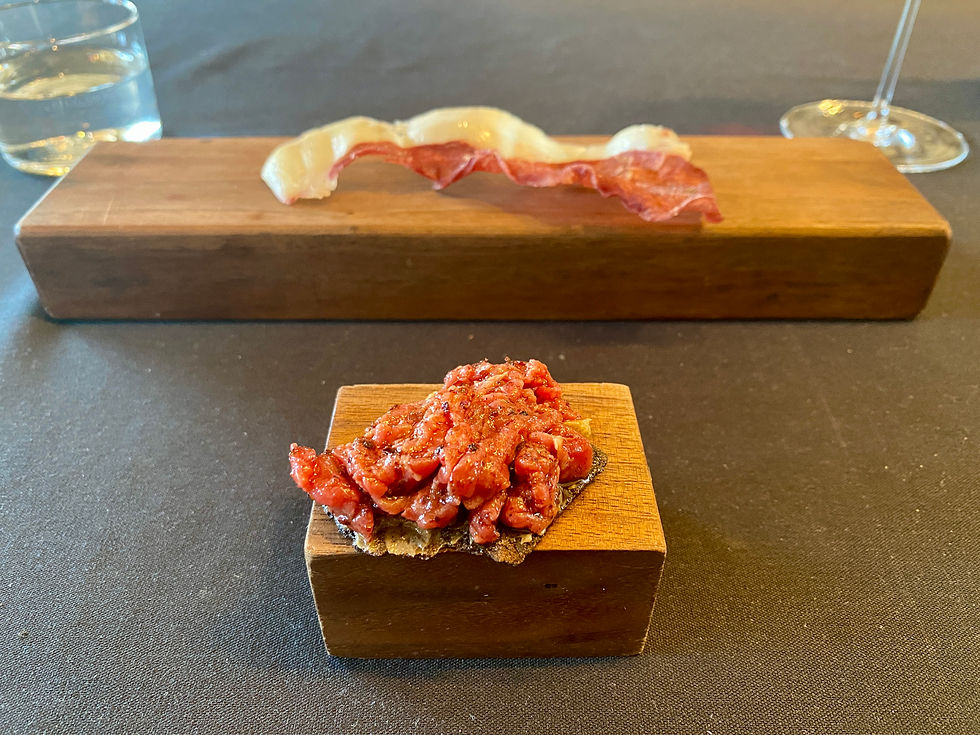
Knowing my penchant for adventurous eating, and exercising Johnny's (and Stone Barns') philosophy of using the entire animal, the kitchen brought me a sampling of various offal from the cows along with some "wild things." Interestingly enough, Johnny also grew up a picky eater, and yet became a chef, and my picky eating gave way to becoming a vacuum––I can't imagine telling ten-year-old Steven he would be eating this dish!
From the top, clockwise, was beef pancreas, beef tongue, beef heart, and beef kidney. The wild things followed: pickled wild fiddlehead, asparagus, and ramps, cooked nettles, and a grilled oyster mushroom. The pancreas actually ended up being my favorite, and it kinda reminded me of veal sweetbreads. The kidney was my least favorite––the flavor was just too aggressive and I found it to be a bit under-seasoned. But, I will say I really appreciated the way the wine did, indeed, change character with each bite of a different part of the cow. Really special.


The next dish was special not just for its food, but also for what it was served on. These clay plates were collaborations between Johnny and Greg Moore, who makes the dishware for Stone Barns. Johnny is famous for making his own clay dishware that he uses at / Shed, and he formed these in an earthen pit kiln on the Stone Barns property fired with cow pies, an excellent source of kindling (and a fairly inventive way to use "every part" of the animal!). The three types of dishes they made together were named "Earth, Fire, Water", and consisted of a bowl for serving tortillas, these dinner plates, and the beautiful water jug that graced my table throughout the meal.
On the plate was red chili-braised beef short rib with cooked roots and leaves of hon tsai tsai, a Chinese green, from the greenhouse. But the real prize of this dish was the bowl housing two incredible corn tortillas that were hand-made and cooked in the horno. These tortillas have ruined tortillas for me. They were so good. I made little tacos with them, as suggested by Jenny. Fucking fantastic.



I thought that would be the end of the savory courses, but I was thrilled to be offered more wine by Hannah, indicating that more food was to come! Hannah and I nerded out a bit when she brought this wine––we both love new world syrah, particularly from cool climates, and she offered me an example from the Sonoma Coast from producer Pax Mahle. This thing just sang; it was high-toned, almost effervescent, and loaded with blue fruit and flowers. I love these cool climate California syrahs, and it would prove to be a great pairing with the next course.
Oopsie though... I was also brought a beer to pair! Johnny prefers beer with his food, and this was a really special niche beer made specifically for this residency through a collaboration with Hudson Valley Brewing and The Test Brewery, called "dwelling." They brought hops that grow wild in bushy brambles in the high desert of New Mexico to Hudson Valley to be used for this beer, which was a sort of hybrid-like farmhouse ale and sour. It was absolutely delicious, and it was interesting to alternate between the syrah and the beer for the pairing.


Posole is a classic southwestern soup. Traditionally made with pork, this one was made with... you guessed it... Stone Barns beef! The broth and slow cooked beef were both delicious, but the most sensational aspect was the hominy-like puffed otto file corn, the same corn I had during Shola's residency in February. Johnny also brought some wild oregano from New Mexico to include in this dish. Alongside was some butter from Blue Hill dairy cows (they really are using everything they can from the cow!) and a (fairly out of place but delicious) radish from the farm, as well as flour tortillas made in the horno (again, I am now ruined for flour tortillas) and some extra chili paste in case I wanted more flavor and spice. I definitely wanted more spice, and used all of it in the posole. It was so good.
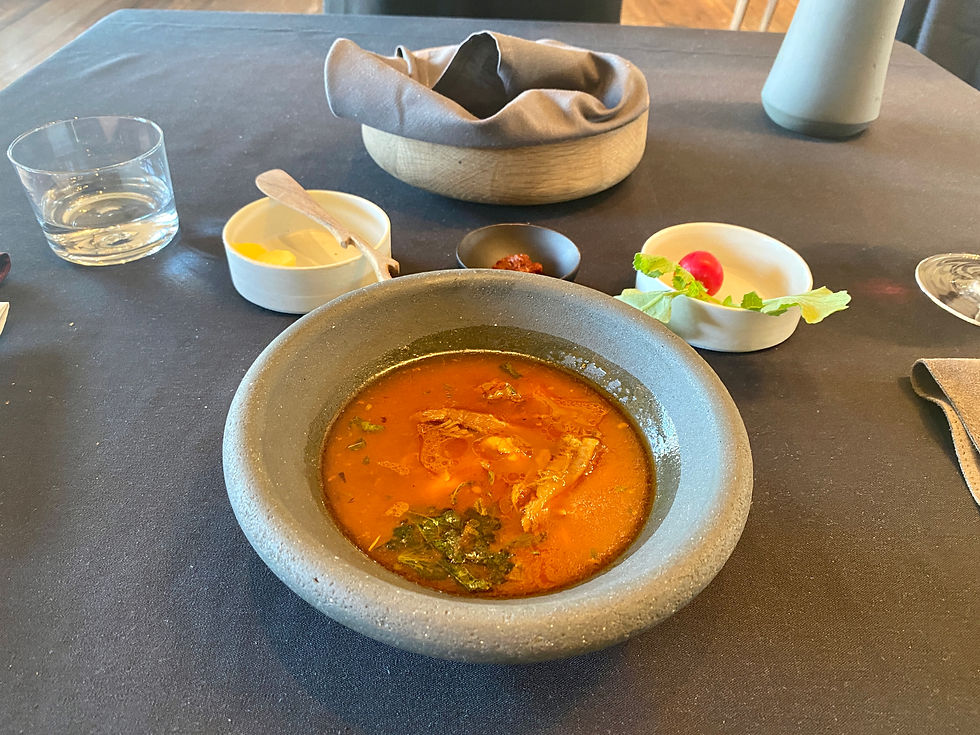
I honestly was absolutely floored by how magnificent the savory courses were. There were very few bites that were anything short of phenomenal. I tasted more wild foods that I'd never had than ever before in a single meal, and the simplicity, purity, and integrity were extraordinary. Combine that with how much I connected to the food as a child of the west, and you have the makings of one of the best meals I have ever had the privilege to enjoy. I honestly thought about making another reservation so I could experience it again. It was THAT good.
And that was even before the dessert courses. The first was maple ice from sap from the Hudson Valley with dead nettle flowers. Delicate, subtle, and a perfect little sweet transition to the sweet courses.

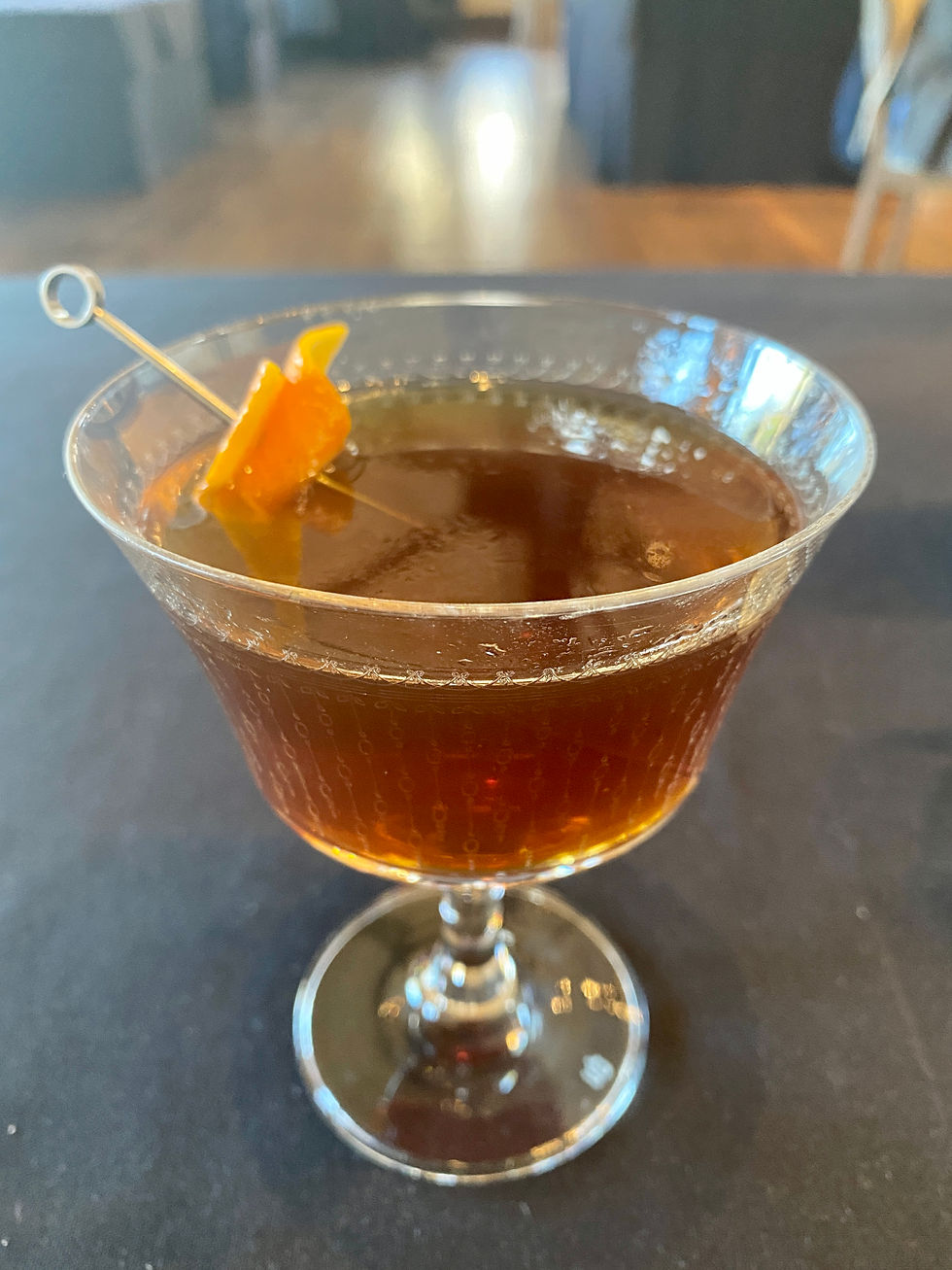
Hannah asked if I wanted something else to drink with dessert, which I, of course, did. She suggested the Calvados-based cocktail on the list, which included wild meadowsweet and Eau de Vie du Cidre. A great after-dinner drink––Calvados is an apple brandy that has swiftly become one of my favorite spirits. In fact, Calvados is the spirit in my current favorite cocktail, which is a variation on a French 75 that uses Calvados instead of gin, a semi-sweet and funky sparkling rosé called Cerdon de Bugey in place of the Champagne, and lime juice in place of lemon. I got so excited about the Calvados that I even told Hannah about this cocktail, and she was fascinated and clearly wanted to give it a go as well!
The next course was a sweet rice porridge with chufa seed custard, milkweed, and golden raisins smoked in the horno. Insanely good. So good I forgot to photograph it! The rice porridge was creamy and loaded with flavor, but the simultaneously smoky and sweet raisins were rockstars. Finally, I was served cherry twig ice cream with a sour birch syrup and grilled cherries. The cherry twig ice cream was subtle and delicious, while yet another otherwise sweet fruit was complemented by some smoke from the cooking process. So good. Johnny was continuing to knock it out of the park, even in the dessert courses, which can sometimes not shine as brightly as the savory courses in tasting menu meals.

The last two bites included a rye and anisette cookie and a black walnut and candy cap mushroom tamale. Both were delicious, but the homemade vermouth they paired with it was the real star––they used fermented honey and koji vodka, adding bitter wild botanicals. So flavorful and interesting!


Surprise! Evan brought me an extra little treat, which turned out to be the exact same French 75 variation I described to Hannah just minutes earlier. Evan said he'd never seen Hannah so excited as when she found some Cerdon in the cellar, and the bartenders made up a spectacular Stone Barns version of the drink. Just as delicious as always, and made even more special by the gesture! Especially when brought by the adorable Evan. I definitely have a little crush.

I waited for some time after I finished my last bites and sips to get a chance to meet and chat with Johnny, who hadn't made an appearance in the dining room yet. Jenny assured me that "we've been planning for the whole meal for him to come meet you," and though I waited a while, it was wonderful to talk with him for a moment. I shared that I was also from the western high desert, and how much I missed that part of the world, and how alienated I feel at times out east. He responded with "yeah, I try not to brag to people here, but we really are lucky out there." I couldn't agree more.
This meal was special. It existed at the intersection of many important currents in my life, such as my new fascination with wild foods and indigenous food practices, my special relationship with the west, and (perhaps most important) my new status as a fully vaccinated person. It will be a long time before I have a meal that spoke to me as profoundly as this one did. And I cannot tell you how happy I am to have a place like Stone Barns, a place that feels more and more like a home, just a short flight away. I look forward to continuing to patronize this special place and experience all they have to offer. There's one more residency this season, and it seems they will be doing more chef residencies this summer, so I will have to keep myself updated on the goings-on!
Now that I am fully vaccinated, there's so much upcoming I am excited to share! Keep an eye on the blog, and keep safe!







